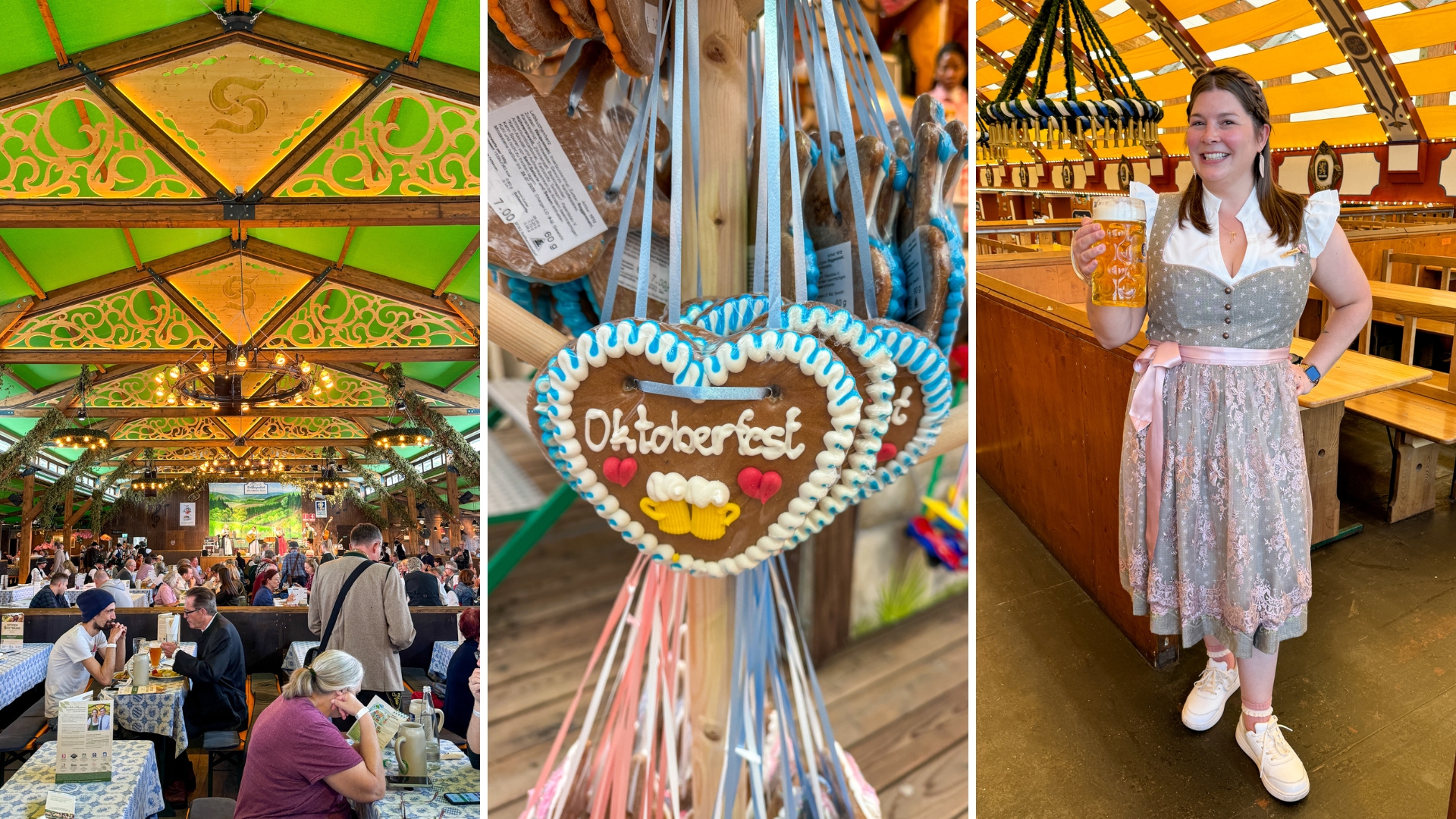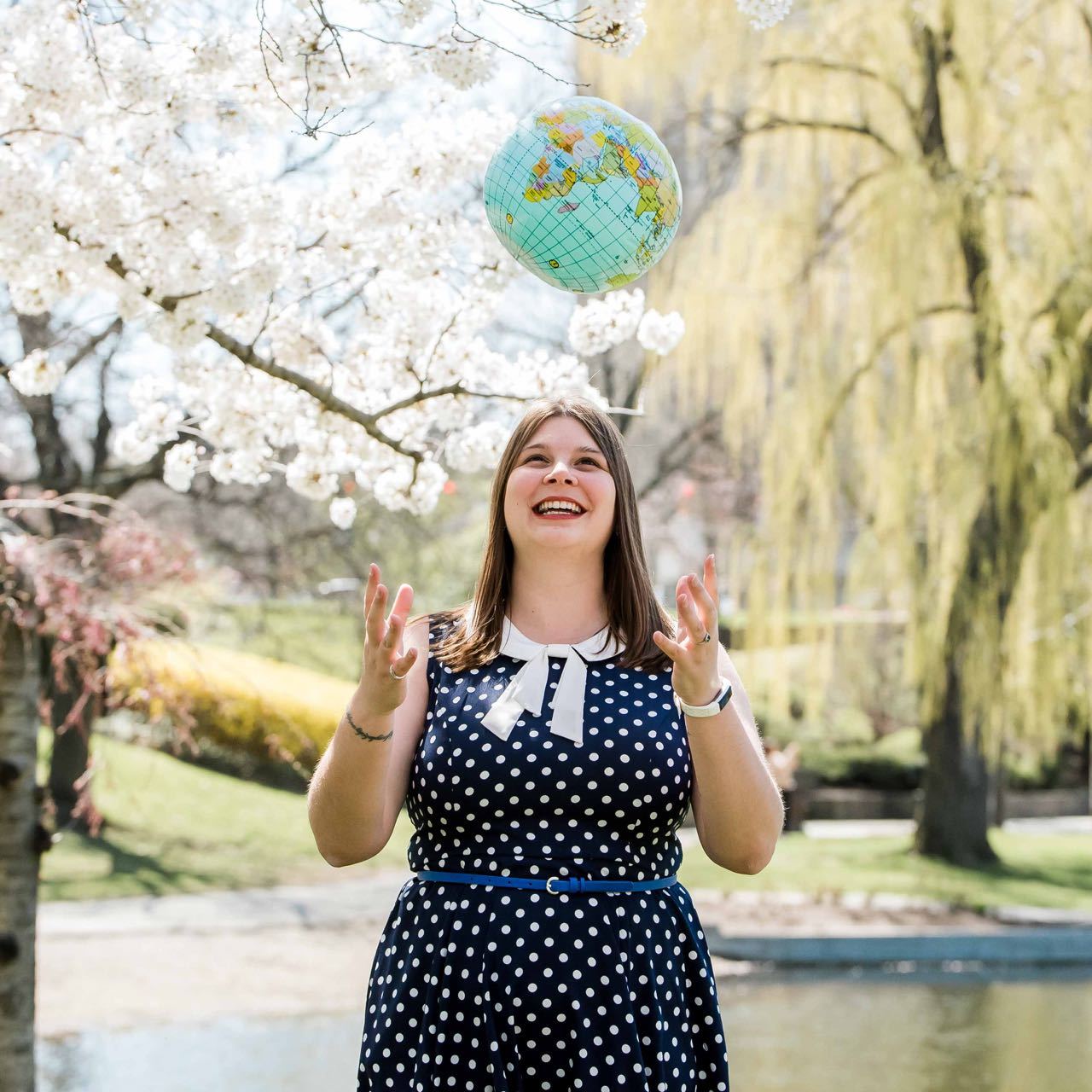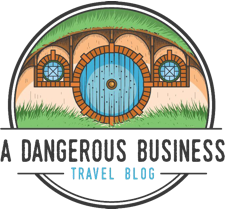16 DOs and DON’Ts for Your First Trip to Oktoberfest in Munich

So you're heading to Oktoberfest in Munich and aren't sure what to expect… that was me not so long ago before my own first trip to the Wiesn!
Oktoberfest – the annual 2-week-long beer festival in Munich – is one of the biggest festivals in the entire world, drawing millions of people every year. And, despite what you may assume about it, it's NOT solely about drinking beer (though of course beer drinking is a big part of it).
You might not know that Oktoberfest is also about amusement park-style rides, German food, and live music. Or that they tear down and rebuild the entire thing every year. Or that you don't HAVE to drink beer at all if you're like me and don't like it!


If you're planning an Oktoberfest trip this year or anytime in the future, keep reading for all my tips and things you need to know!
16 DOs and DON'Ts for Oktoberfest in Munich
Here are all the things I think you should know before going to Oktoberfest in Munich.
DO know the history of Oktoberfest
The tradition of Oktoberfest dates back to the 19th century. The very first “official” Oktoberfest celebration took place in Munich on October 12, 1810, and it was actually a wedding celebration for Crown Prince Ludwig and Princess Therese of Saxony-Hildburghausen. Which makes total sense when you actually get to Oktoberfest, because being in the tents 100% feels like a really big wedding reception with a dress code and huge beers!

Today, Oktoberfest happens annually in Munich for roughly two weeks, starting in mid-September and ending the first Sunday in October. (The exact dates change year to year, and the celebration can technically be anywhere from 16-18 days long, depending on the calendar.)
Knowing the history of the festival definitely helps you know what to expect. (I describe Oktoberfest as a massive county fair meets the biggest wedding reception you can imagine.)
DO wear comfortable shoes
Oktoberfest takes place at the same place in Munich every year: at a massive festival ground known as the Theresienwiese (named for Princess Therese!), which is often just shortened to “the Wiesn.” This festival ground near Munich's main train station is huge, covering more than 100 acres.

There are multiple large tents, plus a Ferris wheel, carnival rides and games, food stands, and more. Add to this that you will likely arrive on foot and might spend a bit of time standing in the beer tents, and good shoes are pretty much essential for a comfortable Oktoberfest experience!
While some locals might wear traditional shoes to go with their dirndls or lederhosen, I recommend opting for comfort over fashion if you're just visiting for a few days. (I wore sneakers to Oktoberfest, and that's what my Oktoberfest-pro friend Ashley often wears, too!)
DON'T wear a costume; DO wear Trachten
Speaking of what to wear, yes, this is a festival that lots of local German people attend every year, and most come decked out in their best dirndls (for women) and lederhosen (for men). These outfits are NOT costumes; they're Tracht or Trachten, which are traditional Bavarian outfits with cultural meaning.
And this is one case where even non-locals are absolutely encouraged to do as the locals do! While you don't HAVE to dress up, you definitely can wear a dirndl or lederhosen even if you're just a tourist. BUT, make sure it's close to traditional and NOT a Halloween costume.

For women, a traditional Bavarian dirndl will consist of 3 pieces: a blouse (that's usually white), a dress that's fitted in the bodice and usually goes at least to the knee, and an apron. For men, the traditional outfit consists of leather knee-length shorts (sometimes with suspenders), a collared (often checkered) shirt, knee-high socks, and a vest and hat if you really want to complete the look.
My friend Ashley has this super detailed guide on what to wear at Oktoberfest and where to find it. But basically, if you're gong to order your outfit online, just be sure it's NOT a one-piece Halloween costume; everyone can tell and will absolutely judge you for it.
Pro tip: You CAN order Oktoberfest outfits on Amazon. Just look at the listing objectively, and make sure whatever your ordering has the proper amount of pieces, and doesn't cost like $19. I ordered my dirndl from Edelnice Trachtenmode, and paid about $120 for just the dress and apron.
But remember, you don't HAVE to dress up at all. You totally can go to Oktoberfest in street clothes; there's no actual dress code for this festival, and nobody really cares whether you dress up or not. (But it IS lots more fun if you are able to go all-in on an outfit.)

DON'T buy tickets
Entry to Munich's Oktoberfest is FREE. It's free to get in to the grounds, and all the tents are free to enter, too (though if they're at capacity you might not be allowed in). What you'll pay for is beer, food, rides, souvenirs, etc. Don't get scammed into buying Oktoberfest entry tickets of any kind.
The ONLY time you might pay to enter Oktoberfest is if you book some kind of guided tour or experience that includes a table reservation and food/beer. For example, this tour and this tour both offer one-day guided tours of Oktoberfest with table reservations plus beer and food included, and would be a great way to experience Oktoberfest if you're on your own. Thirsty Swagman also offers guided Oktoberfest tours that include all of the above for multiple days, plus hotel accommodation.

(You will have to pay to enter the Oide Wiesn area, but I'll cover this later!)
DON'T bring a big bag
Speaking of entering the Oktoberfest grounds… there is a security/bag checkpoint, and you're not allowed to bring in backpacks or any large bags at all. (The official bag size limit is 3 liters, or bags no bigger than 20 cm x 15 cm x 10 cm (approx. 8 in x 6 in x 4 in)). So ladies, small purses and bike shorts with pockets under your dirndl are your friend!
DO visit multiple tents
The “tents” at the real Oktoberfest are not like whatever your town sets up for its version of Oktoberfest. These tents in Munich are full-on wooden buildings with usually 2 levels and towering ceilings. Every tent has a different theme and vibe, and each is filled with rows of wooden tables and benches that hold thousands of people.
I definitely recommend exploring as many tents as possible! (My favorite afternoon at Oktoberfest was spent tent-hopping!)


The main (big) tents to know about are:
- Armbrustschützenzelt – The crossbowmen's tent; and yes, there's a crossbow shooting range attached. This tent also has a really fun band.
- Augustiner Festhalle – Known for its green ceiling and Augustiner beer poured straight from wooden barrels.
- Fischer-Vroni – They serve the famous fish on a stick here.
- Hacker-Festzelt – One of the prettiest tents, with a ceiling that looks like the sky.
- Hofbräu-Festzelt – THE party tent at Oktoberfest.
- Käfer Wiesn-Schänke – This smaller tent more closely resembles an alpine cabin than a tent, and is typically the place to go celebrity-spotting and swap beer for champagne. (I personally found this one a bit too claustrophobic to enjoy!)
- Kufflers Weinzelt – Yes, there's a wine tent! It also gives cozy vibes.
- Löwenbräu-Festzelt – The one with the giant lion outside. It's a cheery yellow inside.
- Marstall Festzelt – One of the prettiest tents, with an Art Nouveau façade and a horse theme inside. The band is even up on a revolving stage shaped like a carousel!
- Ochsenbraterei – Head here to eat something a bit different: roast oxen!
- Paulaner Festzelt – Serving classic Paulaner Oktoberfest beer and Bavarian food, this tent also has a popular outdoor beer garden.
- Pschorr-Festzelt Bräurosl – The newest tent, unveiled in 2022.
- Festhalle Schottenhamel – This is the oldest tent at Oktoberfest, and it's where the first beer barrel of the festival is tapped each year.
- Schützen-Festzelt – This tent has both a beautiful balcony that looks out towards the Ferris Wheel, PLUS an indoor shooting range. Arnold Schwarzenegger is often spotted at this one.


And the big tents inside the Oide Wiesn (which I'll talk more about later) are:
- Boandlkramerei – New in 2024, this tent has room for dancing, and you can catch a musical cabaret performance twice a day.
- Festzelt Tradition – This huge tent has a big dance floor and serves beer in stone mugs.
- Volkssängerzelt Schützenlisl – Probably the prettiest tent in the Oide Wiesn, this tent celebrates traditional folk singing.

And then there are even more small tents to explore around the Oktoberfest grounds, too! The big tents can hold thousands of people in indoor and outdoor areas, which is how this festival can host millions of people each year.
Definitely visit multiple tents to soak up the different music and vibes, and to try different food and beer!
DO know what kind of experience you want
Oktoberfest runs for more than two weeks, with tents opening each day in the morning and serving beer until usually 10:30 at night. There are SO many different tents at Oktoberfest, and each one offers a slightly different experience when it comes to the decor, music, food, and general makeup of guests – and it can change entirely depending on what time of day you go!
So to make things less overwhelming, it's helpful to figure out what sort of Oktoberfest experience you want to have before you go.

If you want to full-on party and drink tons of beer, then you'll want to visit the bigger tents in the evening – and especially on weekend evenings. This is the loudest, rowdiest time at Oktoberfest. (And the Hofbrau tent will have the most epic party vibes.)
Conversely, if you're looking for a quieter Oktoberfest experience, you'll want to go during the day on a weekday. You can still get food, drink beer, and listen to music in all the tents at lunchtime – just without the nighttime crowds. You can also head to the Oide Wiesn for even more chilled-out vibes.
DO explore outside of the tents
There's more to do than just drinking at Oktoberfest! I honestly was not aware of this before I started planning my own trip, so don't feel bad if you had no idea, either.
The Theresienwiese is mostly covered in all those large festival tents, but it also has carnival rides and games, smaller tents to drink in, souvenir stands, and even a giant Ferris wheel.


My favorite things to do outside of the beer tents at Oktoberfest were:
- See the horse teams – Every morning, all the major breweries with tents at Oktoberfest bring decorated beer wagons pulled by teams of draft horses to the festival grounds. The horses are usually “parked” outside the major tents for a few hours each day, making for some great photos!
- Ride the Ferris wheel – The Willenborg Ferris wheel has been operating at Oktoberfest in Munich since 1979, and will whisk you 50 meters (164 feet) above the Oktoberfest grounds. From there, you get a great view of Munich, and on a clear day can even see mountains!
- Go into the Teufelsrad (Devil's Wheel) – The Devil's Wheel is basically a large, slightly slanted disc on the ground inside a small tent. Groups of people are called to come sit at the center of the wheel (groups can be things like “kids aged 5-10” or “men wearing lederhosen” or even “police officers”), and the goal is to be the last one left as the wheel spins faster and faster. The wheel uses centrifugal force to dump people off it – but things like ropes and padded balls are often used as obstacles, too. You can go in and just watch, even if you don't want to participate (you will have to pay to enter this tent; last year it cost €5).
- Watch people at the Toboggan slide – If people-watching is your jam, head over to the Toboggan ride. This is just a simple toboggan-style slide – but to get onto it, riders have to use a fast-moving conveyor belt to get to the stairs. When you add mildly inebriated people to this equation, hilarity often ensues.


DON'T skip the Oide Wiesn
I've mentioned the Oide Wiesn several times, and now we're gonna talk about it! Oide Wiesn translates to “Old Oktoberfest,” and basically is the old-timey section of Oktoberfest. You do have to pay to enter this area (it usually costs about €4), but this means it's usually really chill and quiet here.
You'll find the same types of things in the Oide Wiesn as elsewhere at Oktoberfest – just with a nostalgic bent. There are tents serving beer; Bavarian folk music; historical rides and games; a puppet theater; and even a museum tent with children's programming.
I really enjoyed this part of Oktoberfest. It was a great place to visit on a Saturday afternoon when the regular beer tent crowds got to be too much.



For even MORE Oktoberfest tips, check out my friend Ashley's site; she has worked as a tour guide at Oktoberfest for years, and is the real pro! I joined a Thirsty Swagman tour of hers last year, and it's a great way to experience Oktoberfest in Munich.
DON'T be surprised to see kids
Oktoberfest might be known for its liters of beer, but it's actually quite a family-friendly event, especially during the day. Kids are welcome in all Oktoberfest tents and on the rides, and there are even family days at the festival. People absolutely can and do bring kiddos to the Wiesn.
You can take the kids to Oktoberfest at night, too, but just be aware that kids between 6 and 16 must be accompanied by an adult in tents after 8 p.m., and kids under 6 (or kids that *look* like they're under 6) are not allowed in the tents at all after 8 p.m.

You DON'T have to drink beer
As someone who does not drink beer (like, at ALL), I always assumed it wouldn't be worth it for me to go to Oktoberfest. But you can absolutely enjoy the beer tents without drinking any beer!
Entry to the tents is free, so technically you could go in and not drink anything at all. But most likely you'll want to drink *something.* Along with liters of beer, you can also order soft drinks, water, juice, and even wine.
My friend Ashley often drinks radlers (beer mixed with lemonade) at Oktoberfest for something lighter. And on my first day in the tents, I was ordering Apfelschorle, which is apple juice mixed with sparkling water. (You can order Apfelschorle by the liter, and it LOOKS like beer – in case you want to get your standard Oktoberfest photos without wasting beer.)


Of course, there's only so much apple juice a digestive system can take, so I switched to sparkling water by the second day. And guess what? NOBODY CARED. Drink whatever you want.
DO bring cash
An important thing to know about Oktoberfest is that its a cash-only environment inside the beer tents. So be sure to bring cash (and by cash I mean strictly Euros) with you. You'll order your drinks and/or food, and then pay your server when they deliver it to your table.
(And if you're curious about prices, expect to pay somewhere around €15 for a liter of beer.)
You'll also want Euro coins (especially €1 coins) for tips and bathroom money. It's standard to tip your server €1-€2 every time they drop something off at your table, and it's also standard to pay €0.50-€1 to use the toilets, especially the women's toilets. (This is because the women's toilets at Oktoberfest tents are actual bathrooms with stalls, which are generally kept pretty clean and stocked with toilet paper by a bathroom attendant, which is who you are paying!)

DON'T skip the food
If you're like me (a gal who grew up in the agriculture-heavy Midwest), you probably associate festivals that feel like county fairs with heavily-fried food truck-style food. And you can indeed find *some* of that at Oktoberfest. But the food inside the tents? It's legit pretty good!
Each tent has a slightly different food menu (and some have specialties, like the oxen at Ochsenbraterei and the fish at the Fischer-Vroni tent), but you can generally expect to find Bavarian specialties at most of them. So don't skip the hearty traditional food!


During my time at Oktoberfest, I had a nice roast chicken, a HUGE plate of Käsespätzle, and of course a pretzel as big as my head.
DO expect to sit with strangers
Tables at Oktoberfest are meant to hold 8-10 adults – that means 4-5 people on each bench. And, unless you've reserved an entire table for yourself in advance, you can expect to be sat with complete strangers. It's just how it's done here!
This can sometimes feel awkward at first (like when Ashley and I got sat with a table of Russian ladies in the Marstall Festzelt who were initially NOT happy at having to share their table), but if you cozy up and clink some beer steins a few times, everyone starts to feel like family pretty quickly.

(If you're traveling with a larger group and want to be sure that you'll be able to sit together, though, you CAN make table reservations. Each tent manages its own reservations, and you can find details for each on the official Oktoberfest website.)
DON'T stress about the language barrier
Speaking of sitting with strangers and dealing with German servers in the beer tents, don't stress too much about a language barrier. Almost everyone in Germany these days speaks pretty darn good English, and if you run into someone who doesn't (or claims they don't), numbers on your fingers work the same in every language, and “bier” and “beer” sound the same.
I do speak a little bit of German, but I don't think I used it at all at Oktoberfest other than a quick “danke” (“thank you”) when I ordered/received things.
(And don't worry about not understanding the beer hall chants, either; you'll catch on pretty quickly!)


DON'T be a dick
Yes, people drink A LOT of beer at Oktoberfest, and many of them get pretty drunk. I'm not telling you you shouldn't have a good time, but obviously try not to be a complete asshole about it.
Don't chug your beer (it can actually get you thrown out of some tents). Don't try to dance on the table (it will also get you removed from tents). Don't stiff your servers on a tip. Don't pee anywhere other than in a designated bathroom. Etc, etc.
Oktoberfest is meant to be a big celebration, so let's try to make sure everyone can enjoy it!
And there you have all my top tips for going to your first Oktoberfest in Munich!
Is going to Oktoberfest on your bucket list?

Amanda Williams is the award-winning blogger behind A Dangerous Business Travel Blog. She has traveled to more than 60 countries on 6 continents from her home base in Ohio, specializing in experiential and thoughtful travel through the US, Europe, and rest of the world. Amanda only shares tips based on her personal experiences and places she's actually traveled!










This is my first time going to Oktoberfest and really excited about it. I’ve been searching for advice and Dos & Don’ts and ended up stumbling across this page. great advice and well explained. appreciate the advice =]